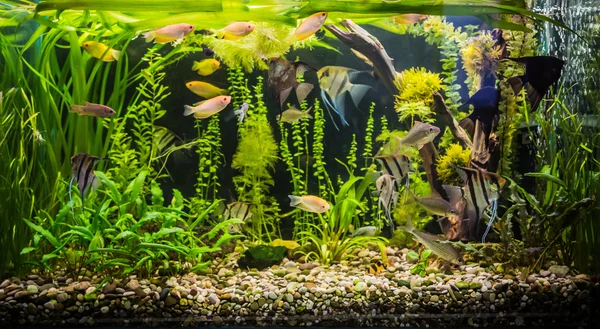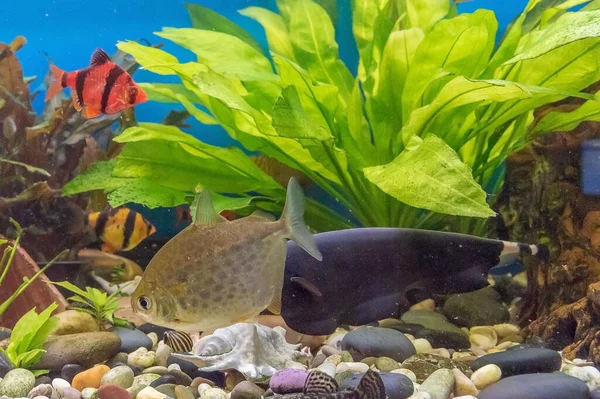Using gavel vacuums is the best way to clean the gravel in your tank, especially when you have excess substrate algae. But without a guide like this, you may have had to break the bank for a vacuum to clean the gravel inside your aquarium.
Perhaps, for this reason, you have been wondering how to clean fish tank gravel without a vacuum. This article is it.
This guide explains how to clean fish tank gravel without a vacuum.
Why You Need To Clean Fish Tank Gravel
The gravel as your aquarium substrate is usually where uneaten food, debris, and fish waste, such as fish poop waste, settle.
If you do not have a regular cleaning routine that properly cleans the gravel substrate, your aquarium will likely experience a nitrate buildup.
As you know, nitrate buildup is bad news for your fish because polluted water poses health risks for the pets.
You need to keep a clean tank with regular water changes and other maintenance routines like cleaning the gravel substrate no less than once every two months.
How Often Should You Clean Aquarium Gravel?

Cleaning fish tank gravel requires consistency. The frequency of cleaning aquarium gravel depends on how big the tank is and the rate at which the fish pollute the water. Some fish produce more fish waste at a much more rapid rate than others.
Another factor to consider is the amount of uneaten food that has sunk to the bottom of the aquarium to be trapped in the gravel substrate.
But generally, it would be best for you to have a consistent routine of cleaning gravel in the aquarium. You can choose to clean the gavel completely every two months or after each water change.
How To Clean Fish Tank Gravel Without a Vacuum
How to clean fish tank gravel without a vacuum is practical knowledge that every responsible hobbyist ought to know.
Knowing how to clean fish tank gravel without a vacuum will come in handy, especially when a vacuum is unavailable.
Check out this detailed explanation of the process.
Set Up Another Tank
This step is a very important step for cleaning your fish tank gravel. You want to start the cleaning process by setting up another tank to hold your fish while you do the cleaning.
You want this new tank to be free from any toxins or chemicals. If any chemical has been used to treat the container, wash the bucket clean and ensure that no chemical residue is left in the bucket, as this will affect the health of your fish.
Choose a container that is big enough to hold all your fish. After setting up this make-shift fish tank, you want to siphon about 50% of your fish tank water into this new tank. This will ensure that the fish are kept in the same water parameters as before while you do the cleaning.
Move Your Fish
After setting up the holding tank, move your fish into this holding tank. Be careful not to hurt them. You can move them with a net or other tools that will not cause any harm to their bodies.
But if you keep fish with long and flowy wings like angelfish and bettas, it would be better to move them into this holding tank with your hands.

Long fins of fish tend to get entangled in nets. When this happens, your fish is likely to end up with damaged wings and injuries.
You want to avoid that by moving them into the holding tank with your hands.
Take the System Apart
To clean the fish tank gravel thoroughly, it would be best to remove the filters, air pumps, lighting systems, decorations, hides, and anything that might get in the way of the cleaning.
You want to take the system apart so that you do not accidentally damage any aquarium appliances. You also want to unplug the electrical appliances attached to the tank and not just the ones inside the tank.
Take out some of the rocks and set them apart in a separate bucket. You want to keep about a cup or two full in a bucket, to be returned later into the tank.
This process is important because if you clean all the tank gravel without setting any aside, you would have lost beneficial bacteria necessary for the breakdown of fish waste in your fish tank. These healthy bacteria are called nitrifying bacteria, and they play a significant role in the aquarium.
So you want to have a cup or two of your tank gravel in a separate bucket to keep some of these healthy bacteria.
Clean Your Aquarium Gravel
While there are many methods to clean your tank gravel without a vacuum, using a strainer is one of the most effective ways. Pour the fish tank gravel into the strainer and put the strainer inside a bucket. Shake the strainer as much as possible under running water to rinse the gravel.
It is important that you do not mix the water with any solution or cleanser. Ordinary tap water is sufficient for straining the fish tank gravel.
You want to repeat this process with running water until you have lost as much grime as possible. You will notice that you have lost as much grime as possible when the water in the strainer runs clear.
If you are using gloves, you want to ensure that the gloves are chemical-free.
Set Up Your Aquarium
After cleaning the fish tank gravel, some hobbyists like to clean the aquarium. If you wish to clean the aquarium, it would be best to do so without harsh chemicals.
Avoid any chances of leaking any chemical residue into the new aquarium water. Any chemical residue in the tank would be harmful to your fish.
But it would be best to clean the whole aquarium before setting your rocks back in. A light cleaning would do as you do not want to remove all the healthy bacteria in the fish tank.
You may use your hand to arrange the clean gravel on the fish tank floor. Remember to add the gravel you set aside earlier for reintroducing the beneficial bacteria back into the aquarium.
Return the tank decorations and all the other electrical appliances you removed at the start. Arrange everything back in place as it should be; the filters, the air pump, the tank decorations, the hides, and other electrical hardware.
You can slowly fill the aquarium with water using a hose for slow water movement. Test to ensure that they work and pose no risk of electrocution. Test for the correct water parameters after cleaning.
Check the temperature, pH level, water flow, water hardness, and other water parameters. Make the necessary changes to bring the water quality to the ideal condition for your pets.
Related Reading:
Return Your Fish
It would be best to return your fish with the remaining water inside which you set them aside. This will help restore the balance of the ecosystem in the tank with the reintroduction of the beneficial bacteria.
What If You Have Live Plants With Roots Deep in the Substrate?
It may be challenging to empty the tank of the dirty gravel, especially if you have live plants. The obvious reason for this challenge is that the roots of the live plants will be damaged if you remove all the gravel. This will injure and may even kill your plants.
But you can clean your fish tank and the dirty gravel in it without harming your plants. This method is particularly useful when you have live plants.

You need to remove all the electrical appliances and decorations to do this. Leave the plants intact in the gravel. Reduce the water level to about half.
Raise the aquarium gently to slide the gravel and the plants to one side. Work up the dirty gravel and stir carefully around the plants to raise the dirt in the substrate and around the rock.
Clean your fish tank by taking out about 35% to one half of the silty water left in the aquarium. Taking out only one half or about 35% of the silty water left in the aquarium will ensure that the microscopic organisms essential for the ecological balance of the tank repopulate themselves in the new water.
There are other ways to clean gravel in fish tanks. Check out this video to know more.
Final Thoughts
Cleaning aquarium gravel with or without a vacuum is one sure way to have fish tanks smelling and looking fresh again.
With this guide, you are guaranteed to save yourself the stress of investing more than you should in the task.
You want to ensure that you rinse with clean water that has not been contaminated with chemicals all through the process.
After setting up the fish tank, you also want to ensure that the water level is the same as before and the parameters are also the same. This is important to prevent stress from a rapid change in the environment.
Related Reading:


